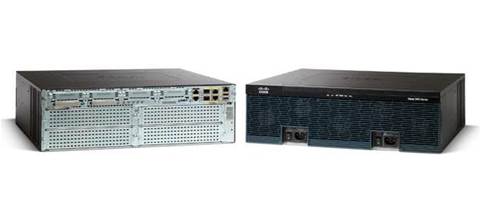Cisco Systems has announced a second generation of its Integrated Services Router (ISR) router, building a server and storage into the unit to allow its features to be updated remotely.
Cisco shipped some seven million units of the first generation ISR, which tends to be used to provide services at branch office level.
Five years on, the vendor claims to have developed a second generation with five times the performance.
The ISR G2 comes with support for the encoding and decoding of video, but it also features embedded server hardware and one terabyte of on-board storage such that the unit is capable of providing local services - even when disconnected from the core network.
Mark van Hoof, product Manager of Cisco's access routing technology group said the hardware on the router is "comparable to a high-end branch office server" and can run embedded Linux or Windows operating systems.
Van Hoof said this allows organisations to remotely roll-out updates to the router. Organisations investing in a fleet of ISR G2's, he said, can "pre-position the hardware" in branches initially and pay to update the router with new software smarts at a later date.
"That removes the need for a remote site visit when you add a new service," he said. "If you had over 1000 sites, and a remote site visit to update the firmware cost $1000 dollars per site, you've just saved a million dollars. So it's much easier with this router to show a more attractive return on investment for turning on new services."
Telstra impressed by early trials
It is this remote management function that most impressed Australian carrier Telstra, which manages some 50,000 ISR units on behalf of its managed IP network customers and uses around the same number in its own network.
Philip Jones, executive director of data, IP and enterprise services at Telstra said the carrier gained "early access" to the ISR G2 at lab stage and has been actively testing units on its network.
"All the staff see it as a positive - the device is faster and more efficient," he said. "But the biggie for us is the ability to manage services remotely through software updates. That makes the coordination of new services through to branches a whole lot easier."
Jones said Telstra has experienced huge growth in the provision of IP VPNs in the past 18-24 months.
The embedded server and storage in the ISR G2 will more easily enable Telstra to sell managed services on top of these IP networks, he said.
"We can incrementally offer video services, IP Telephony, security," he said.
"One of the hidden benefits for the customer is that they no longer have to be so certain about the timing of the scaling of their business. The remote update allows them to be flexible."
Jones said it was also important to Telstra that the G2 was built for control using Cisco's existing management tools.
"The key thing for us to do is offer a seamless service," Jones said. "I don't think we'll need to be going out with forklift upgrades. We'll upgrade depending on the lifecycle of the gear we have out there, on a case-by-case basis."
Van Hoof claimed that 90 percent of modules and interface cards applicable to the first generation of ISRs are still "supportable and usable" by the second generation of products.
Pricing
The ISR G2 comes in three flavours - the 1900, 2900s and 3900 series - each with incremental gains in the number of module and interface slots available and added storage capacity.
The 1900 series offers a broader range of security and wireless options than the first generation, the 2900 offers unified communications, video support and application services capabilities in addition, while the 3900 also offers WAN optimisation.
Australian pricing for the 1900 series starts at AU$2665 and peaks at around AU$22,000 for the 3900 series.








_(11).jpg&h=142&w=230&c=1&s=1)



.jpg&w=100&c=1&s=0)
_(8).jpg&w=100&c=1&s=0)









